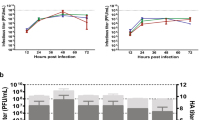Summary
An influenza B virus was passaged in man (virus A) and then in human embryo trachea (C) and into embryonated eggs (D) or directly into eggs (B). Virus A, B, and C had the same (cell-like) haemagglutinin phenotype on reaction with selected monoclonal antibodies while D had an “egg-like” phenotype. The viruses were administered at a dose of 1,000 TCD50 (for MDCK cells) by intranasal inoculation to groups of 27 or 28 volunteers. Viruses A, B, and C all produced disease in six to eight volunteers, whereas D produced no illness and only four volunteers were infected. The viruses shed by the volunteers were indistinguishable from those with which they were inoculated. The haemagglutinin genes of the viruses were sequenced and changes were detected indicating amino acid substitutions at position 196–198 in the attenuated egg-grown virus D whereby a potential glycosylation site present in the other viruses was lost.
Similar content being viewed by others
References
Beare AS, Reed SE (1977) The study of antiviral compounds in volunteers. In: Oxford JS (ed) Chemoprophylaxis and virus infections of the respiratory tract, vol 1. CRC Press, Cleveland, pp 27–46
Caton AJ, Brownlee GG, Yewdell JW, Gerhard W (1982) The antigenic structure of the influenza virus A/PR/8/34 haemagglutinin (H1 subtype). Cell 31: 417–427
Krystal M, Elliott RM, Benz EW, Young JE, Palese P (1982) Evaluation of influenza A and B viruses: conservation of structural features in the haemagglutinin genes. Proc Natl Acad Sci USA 79: 4800–4804
Oxford JS, Corcoran T, Knott R, Bates J, Bartholomei O, Major D, Newman RW, Yates P, Robertson J, Webster RG, Schild GC (1987) Serological studies of influenza A (H1N1) viruses cultivated in eggs or in a canine kidney cell line (MDCK). Bull WHO 65: 181
Patterson S, Oxford JS (1986) Analysis of antigenic determinants on internal and external proteins of influenza virus and identification of antigenic subpopulations of virions in recent field isolates using monoclonal antibodies and immunogold labelling. Arch Virol 88: 189–202
Robertson JS, Bootman JS, Newman R, Oxford JS, Daniels RS, Webster RG, Schild GC (1987) Structural changes in the haemagglutinin which accompany egg adaptation of an influenza A (H1N1) virus. Virology 160: 31–37
Robertson JS, Naeve CW, Webster RG, Bootman JS, Newman R, Schild GC (1985) Alterations in the haemagglutinin associated with adaptation of influenza B virus to growth in eggs. Virology 143: 166–174
Sanger R, Nicklen S, Coulson AR (1987) DNA sequencing with chain terminating inhibitors. Proc Natl Acad Sci USA 74: 5463–5467
Schild GC, Oxford JS, De Jong JC, Webster RG (1983) Evidence for host cell selection of influenza virus antigenic variants. Nature 303: 706–709
Wood J, Oxford JS, Dunleavy V, Newman RW, Major D, Robertson JS (1989) Influenza A (H1N1) vaccine efficacy in animal models is influenced by two amino acid substitutions in the haemagglutinin molecule. Virology 171: 214–221
Author information
Authors and Affiliations
Rights and permissions
About this article
Cite this article
Oxford, J.S., Schild, G.C., Corcoran, T. et al. A host-cell-selected variant of influenza B virus with a single nucleotide substitution in HA affecting a potential glycosylation site was attentuated in virulence for volunteers. Archives of Virology 110, 37–46 (1990). https://doi.org/10.1007/BF01310701
Received:
Accepted:
Issue Date:
DOI: https://doi.org/10.1007/BF01310701



